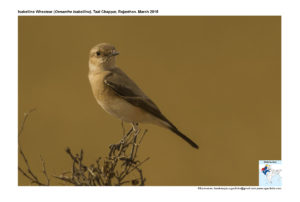Isabelline Wheatear

Isabelline Wheatear Oenanthe isabellina
Etymology:
- Oenanthe : Greek word oinanthe – unidentified bird mentioned by Aristotle
- Isabellina : Latin word for “fawn, greyish-yellow “
Vernacular Names: Baluchistan: Gidik, Guj: Pilopiddo, Mar: RakhatRangoja
Distribution in India:Winter visitor in North West in India.
Description: Size of 16–17 cm; wt. of 21–39 g. It is a large and pale wheatear with larger bill, longer legs , long and pointed wings and short tail. The male is yellowish-grey (Isabelline) from crown to back and wingswith a black alula. It has a strong preocular white supercilium becoming weak and whitish-buff behind eye, blackish loral line, white face and throat with buff-tinged ear-coverts, buffish neck side and breast, white underparts. It has white rump and tail, latter with black central feathers and broad black terminal band; bill and legs are black. The female and first-winter are like male, but loral line are paler, upperparts are paler, buff and whitish edgings of wing feathers are broader. The juvenile is like dull female, with buffier supercilium, faint spotting above and freckling.
Habitat: It is found in arid, open, sparsely vegetated country, including dry plains, mountain and lowland steppes, semi-desert, wadis and desert margins. It is found from lowlands to 4000M.
Food habits: It eats Invertebrates like beetles, caddis flies, lacewings, ant-lions, bugs, termites, grasshoppers, mole-crickets, cockroaches, mantis pupae, dragonflies, mites, spiders, harvestmen, solifugids, scorpions, millipedes, woodlice and mollusc and ants and vegetable matter like Small seeds. It forages mostly in cooler parts of day, using four techniques of bound-and-grab manoeuvres, perch-and-pounce sallying, sallying after flying insects and sally-gleaning. It also digs in ground in early spring, when few invertebrates are on surface, and will then also seek food down rodent burrows.
Breeding habits: They breed in Apr to Jul in Israel and Apr–May in Jordan; Mar–Jun in Armenia and Baluchistan; Feb in Turkmenistan, Mar to Jul in S Russia and Apr to mid-Jul in Mongolia. . The nest is a shallow, bulky cup of dried grass, roots and hair, lined with hair, wool and feathers, placed deep in rodent burrow or burrow of similar mammal, or hole of old bee-eater hole or occasionally natural hole or crevice. They lay a clutch of 4–7 eggs. The incubation period is 14-15 .The nestling period is 15–17 days. The post-fledgingdependence is for 14 days.